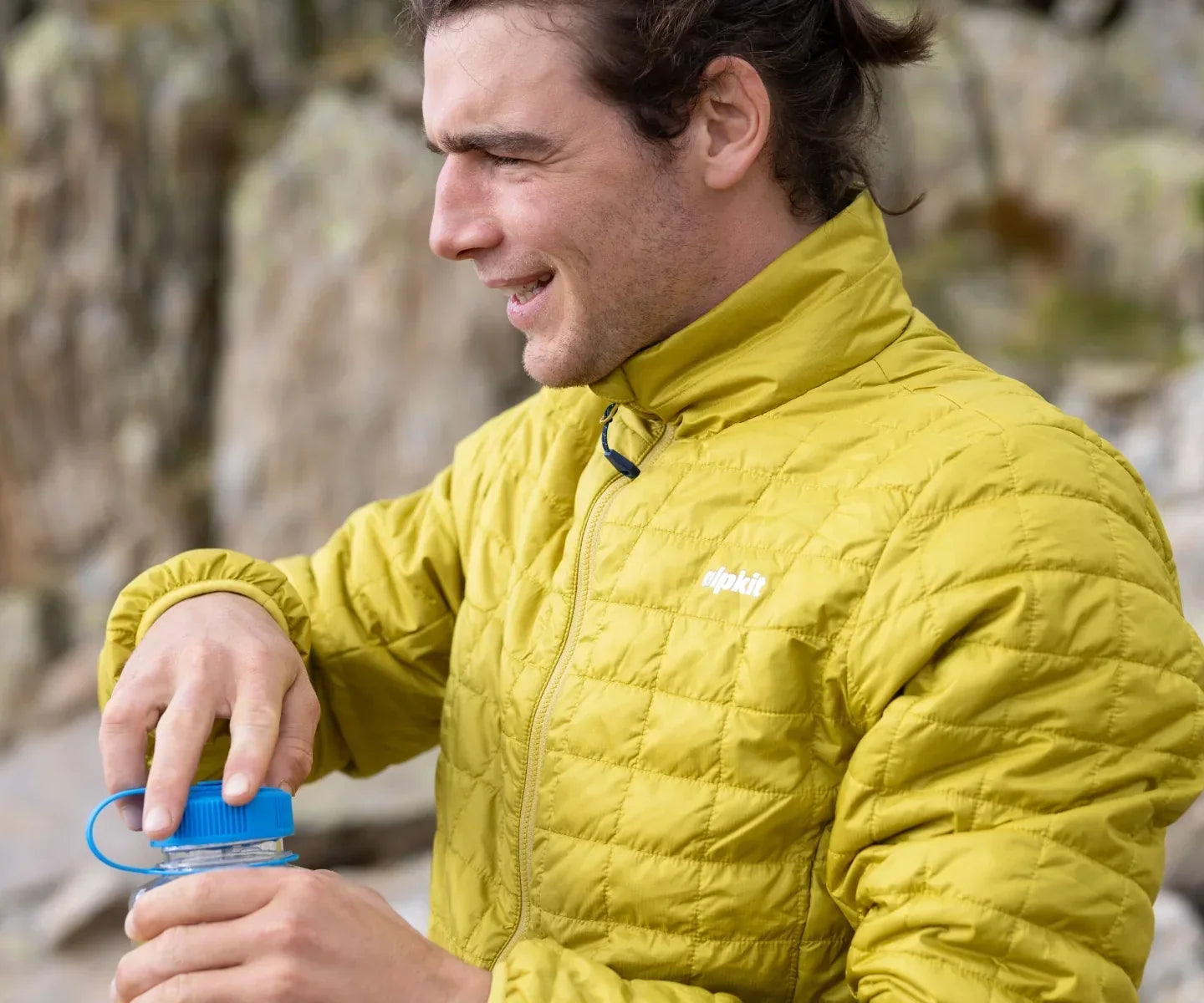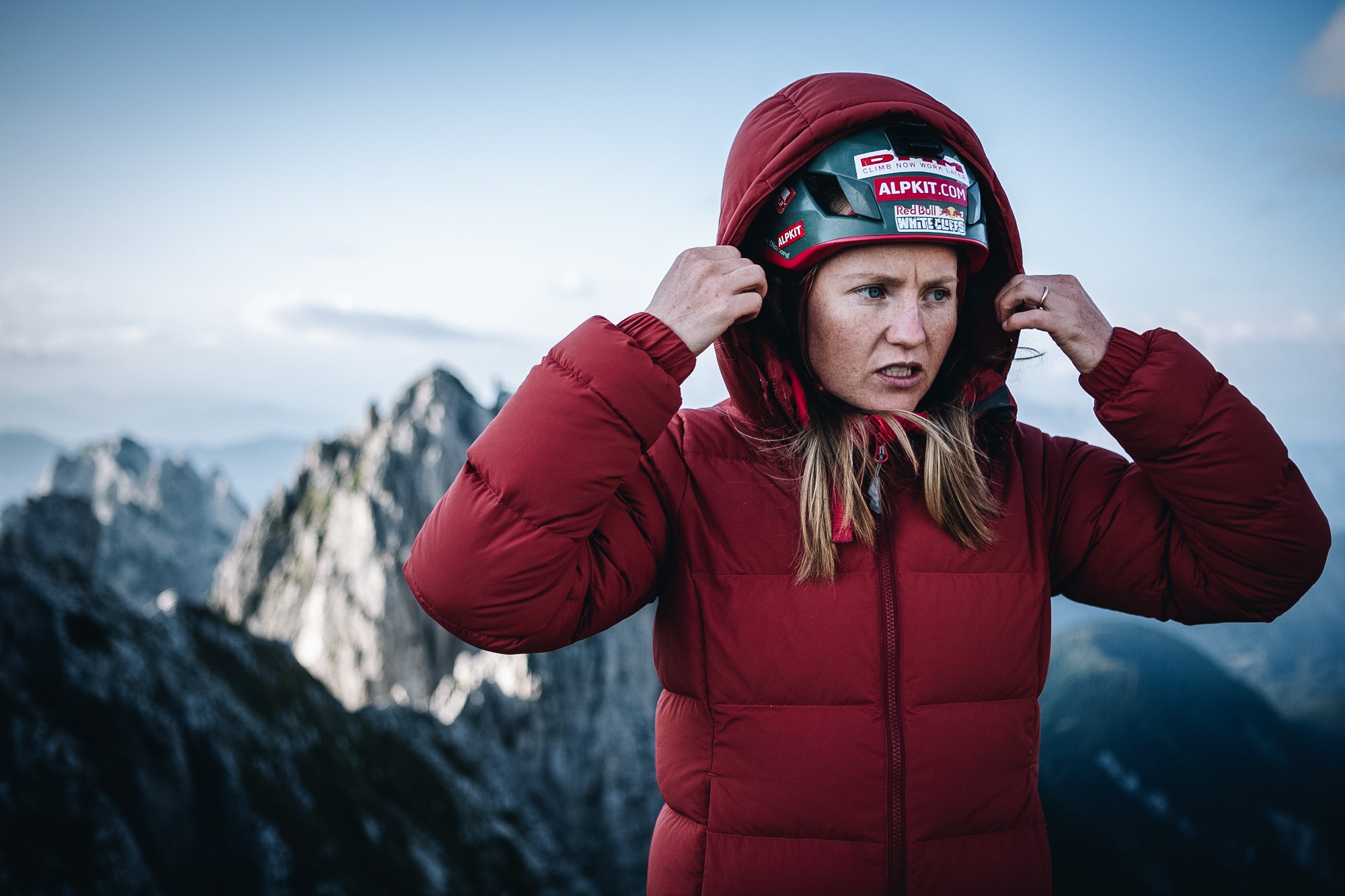
Down and synthetic fills are the 2 most popular types of fill for insulated jackets. We take a look at real-world performance, care requirements and choosing what works for your outdoor activities.
When the temperature drops, the right insulated jacket can mean the difference between an epic adventure and a miserable retreat.
Quick Start: Insulated Jacket Guide
New to insulation? Start with Two Routes to Warmth: Down vs. Synthetic
Choosing down? Jump to When to Choose Down
Considering synthetic? Go to When to Choose Synthetic
Ready to buy? Skip to Making Your Choice: A Simple Framework
The moment everything changes
You've been hiking for hours, warm from the effort and feeling great. Then you stop for lunch at a windy summit, and within minutes you're shivering. Your body heat disappears faster than you thought possible, and you realise why experienced hikers always carry extra insulation.

An insulated jacket isn't just for winter. It's for any time you need instant warmth when your activity level drops or conditions turn cold.
What are insulated jackets and why do you need one?
Insulated jackets are filled with either natural down or man-made synthetic insulation. They work by creating 'loft', a deep fluffy structure that creates tiny pockets of air between the feathers or fibres. Still air is a fantastic insulator, which is why insulated jackets are so much warmer than other outdoor layers.
Two routes to warmth: down vs synthetic
Insulated jackets are designed to trap air and keep you warm. This makes them an essential part of your outdoor wardrobe.
The insulation world divides into two main camps, each with distinct advantages:
Down: nature's insulation champion
Down jackets are filled with the light fluffy feathers found under the breast and underbelly of ducks and geese. Because they're so fluffy, these down 'filaments' create loads of insulating loft for very little weight.
What it is: Fluffy under-feathers from ducks and geese that trap air incredibly efficiently The advantage: Unmatched warmth-to-weight ratio and compressibility Best for: Cold, dry conditions and weight-critical activities
Synthetic: the reliable all-rounder
What it is: Engineered polyester fibres designed to mimic down's properties The advantage: Retains insulation when wet and dries quickly Best for: Damp conditions, active use, and easy care
When to choose down
Down is still the best insulator we have. It provides a high degree of insulation for its weight. It is highly compressible, squashing down small and rebounding back into shape again without getting damaged. These properties are essential when you're trying to pack light or you are short of pack space.

The down advantage
Incredible warmth-to-weight: Nothing beats down for pure insulation per gram Compresses amazingly: Packs smaller than any synthetic alternative Long-lasting: With proper care, quality down maintains its loft for decades Natural and renewable: Ethically sourced down is a sustainable choice
Perfect down scenarios
- Dry mountain environments where wetness isn't a concern
- Weight-critical adventures like backpacking or alpinism
- Severe cold where maximum insulation is essential
- Camp use where you need serious warmth but won't be active
Understanding down quality
The down we use in our down jackets is ethically sourced and certified by the Responsible Down Standard. It meets the highest standards of animal welfare.
What do fill power and fill weight mean?
Fill power (FP) measures the volume of air that 20g of down occupies under strict scientific conditions. It measures how much loft the down creates (how fluffy it is). It's a great indicator of down quality.
Higher fill power down has a better warmth-to-weight ratio. For example, 100g of 800FP down will be warmer than 100g of 650FP down.
Just to confuse things slightly, there are 2 lab tests to measure fill power. The 'US' method gives a slightly higher figure than the same down tested by the 'EU' method. For example 800 (US) would be roughly 750 (EU).
Fill weight measures how many grams of down is inside your jacket. Your jacket's warmth depends on both the fill power and the fill weight. A jacket with lower fill power can be warmer simply because it has more down stuffed into it. The downside is that it will feel bulkier and less compressible.
Fill Power (FP): How fluffy the down is
- 650 FP: Good performance, more affordable
- 750 FP: Excellent warmth-to-weight balance
- 800+ FP: Premium performance, lightest weight
Fill Weight: How much down is in the jacket
- More down = more warmth (but also more weight/bulk)
- Quality matters more than quantity
Construction types
Stitch-through means exactly what it sounds like: each baffle has been stitched all the way through the jacket fabric. Stitch-through construction is the lightest and most compressible. But it can create cold spots along the lines of the stitching.
Box wall construction uses a divider of fabric between each baffle. Each baffle is shaped like a box. Box wall construction allows the down to loft better. But the extra fabric adds weight and makes your jacket slightly less compressible.
Duck vs goose down
Down comes in two varieties: duck and goose. As geese have larger feathers, they generally produce higher fill power down which is more expensive. The best quality duck down is around 650FP. The highest quality goose down can sometimes reach 900FP.
Because duck down has lower fill power you would need more of it to match a goose down filled jacket. The resulting jacket would be heavier, less compressible and bulkier to wear.
Hydrophobic down treatment
Down is naturally hydrophobic. However, when down gets wet, the filaments absorb water, clump together, and lose their warmth-trapping structure. Down also takes a long time to dry out and usually needs to be tumble dried to de-clump it.
To boost down's natural performance it can be treated with a durable water repellent (DWR) coating. The benefits are that hydrophobic down repels water and body moisture for longer and dries quicker.
The DownTek™ PFC-Free Water Repellent Down we use stays dry 13.5x longer than untreated down.
When to choose synthetic
Synthetic jackets are filled with polyester fibres designed to replicate down's properties. Like down, synthetic insulation is warm, lightweight and compressible.
Unlike down, the polyester fibres don't absorb water. So synthetic insulation keeps its warmth-trapping properties even when wet. This makes synthetic jackets ideal for wet climates, or for active use when you're likely to get extremely sweaty.
Synthetic insulation can be manufactured in many forms. From carpets of fibres to individual 'filaments' designed to mimic down. Each type has its pros and cons.
The synthetic advantage
Wet weather performance: Keeps you warm even when soaked Fast drying: Sheds moisture quickly and keeps working Easy care: Machine washable without special procedures Better value: Generally less expensive than equivalent down Consistent performance: Less affected by humidity and compression

How is synthetic insulation measured?
Most brands measure synthetic insulation by grams per square metre. You will see this listed as either gsm or g/m². This measurement can only be used to compare jackets that use the same type of insulation.
Perfect synthetic scenarios
- UK conditions where dampness is always possible
- Active use where you might work up a sweat
- Frequent washing required (travel, regular use)
- Budget-conscious choices without sacrificing performance
Synthetic insulation types
PrimaLoft Gold: Premium performance closest to down PrimaLoft Silver: Excellent value with good performance Active Insulation: Designed for use while moving, more breathable Eco Options: Made from recycled materials for sustainability
What is PrimaLoft?
PrimaLoft is a brand of synthetic insulation. It was first developed in the 1980s to provide a water-resistant alternative to down for military jackets and sleeping bags. Their fibres are specially treated to make them water repellent for even better wet weather performance. PrimaLoft Gold provides the same amount of warmth-to-weight as 550FP down.
PrimaLoft became the market leader for synthetic insulation in the 1990s. Even today people often refer to all synthetic insulation as 'primaloft' (in much the same way we call vacuum cleaners 'hoovers'). We exclusively use PrimaLoft fill for our jackets as they provide the highest quality of synthetic insulation available.
A guide to PrimaLoft insulation
PrimaLoft group their insulation into three broad categories based on how insulating it is:
PrimaLoft Black – A standard of fill for everyday wear, only really used in fashion clothing
PrimaLoft Silver – Excellent quality but good value insulation used in outdoor clothing
PrimaLoft Gold – The highest quality of synthetic insulation available, used in performance outdoor clothing
We use the following types of PrimaLoft insulation in our jackets:
Silver Eco – Insulation using 100% recycled content (like the Heiko jacket with 100% recycled fabrics and fill)
Silver ThermoPlume – Synthetic plumes designed to mimic the loft and compressibility of down feathers. Treated with Cross Core Technology, an 'aerogel' that increases its insulation. (Used in the Talini jacket)
Silver Hi-Loft Ultra – Incredibly lofty and hardwearing insulation that retains its loft well, even after repeated compressions. 70% recycled. (Used in the 0Hiro jacket)
Gold P.U.R.E. – 100% recycled insulation using a manufacturing method that reduces carbon emissions by 70%. (Used in the Sierra hybrid vest)
Gold Active – A mat insulation that can be combined with more breathable fabrics for better ventilation. 45% recycled. (Used in the Katabatic jacket)

What is 'active insulation'?
Active insulation is a type of synthetic insulation that can be combined with more breathable or stretchy fabrics. It is manufactured as a sheet which means it can be used to make breathable jackets like our Katabatic. Well suited to aerobic activity, it allows sweat and excess heat to escape.
Matching jackets to your adventures
For day hiking and walking
Your need: Warmth for breaks and temperature drops Best choice: Lightweight down or synthetic with good packability Key features: Easy to stuff in pack, comfortable over base layers
Example scenario: Chilly morning starts, warm midday, cold evening
For alpine and mountaineering
Your need: Serious insulation for harsh conditions Best choice: Premium down with robust construction or high-loft synthetic Key features: Helmet-compatible hood, durable outer fabric, hand warmers
Example scenario: Belaying in cold conditions, bivouacking, severe weather

For active use (ski touring, winter hiking)
Your need: Warmth that breathes and moves with you Best choice: Active synthetic insulation or light down with good ventilation Key features: Stretch panels, ventilation zips, slim cut for layering
Example scenario: Moving fast in cold conditions, variable activity levels
For travel and versatility
Your need: One jacket that does everything reasonably well Best choice: Quality synthetic or treated down with weather resistance Key features: Packable, versatile styling, easy care
Example scenario: City to mountain, unpredictable conditions, minimal packing
Essential features explained

Hood or no hood?
With hood: Maximum warmth, weather protection, can fit over helmet Without hood: Lighter, more versatile, easier to layer, less bulk
Insulation distribution
Even fill: Consistent warmth, better for static use Zoned fill: More insulation in core, less in arms for better movement Mapped insulation: Varies by body heat zones and activity requirements
Outer fabric considerations
Windproof: Stops cold air penetrating, essential for serious use Water-resistant: DWR treatment sheds light moisture Stretchy: Better mobility and comfort during active use Durable: Reinforced in high-wear areas for longevity
Making your choice: a simple framework
Step 1: Consider your climate
Dry and cold: Down excels Wet and changeable: Synthetic is safer Mixed conditions: Either works, preference decides
Step 2: Think about use patterns
Occasional use: Down's packability wins Regular active use: Synthetic's durability and easy care help Extreme conditions: Both work, but down is warmer per weight
Step 3: Match your budget
Premium: High-fill power down or top-tier synthetic Mid-range: Quality down or excellent synthetic options Value: Good synthetic provides excellent performance per pound

Common mistakes to avoid
Over-insulating: More isn't always better if you'll be active Wrong size: Too tight compresses insulation; too loose loses efficiency Ignoring care: Both down and synthetic need proper maintenance Single-purpose thinking: The most versatile jacket often serves you best

How to choose an insulated jacket
Warmth-to-weight ratio
Ask yourself what your priority is: weight or durability? If you're planning on backpacking or doing anything where weight is a concern, you'll want a jacket that provides the most warmth for the least weight. Hardwearing fabrics like the 0Hiro's nylon 6,6 are useful if your jacket is going to take a beating. Otherwise, you can probably get away with a lightweight nylon ripstop. Water resistance is always useful which is why all our jackets are treated with a PFC-free durable water repellent.
Waterproof
If you plan to use the jacket in wet weather, consider a model with a water-resistant or waterproof shell. Jackets with down insulation may have a water-resistant treatment to help protect the down.
Fit
Are you going to wear your jacket over other layers, or do you need it to fit under your shell as a midlayer? Jackets designed for moving in tend to have zoned insulation (more insulation in the body and less in the arms) and narrower baffles.
Baffles
Narrower, smaller baffles like those on the Filoment and Talini are easier to move in. But they don't provide as much loft and warmth as larger baffles (like those found on the Fantom). Micro baffles usually use a stitch-through construction which creates more cold spots.
Hood
An insulated hood provides vital extra warmth in the very coldest conditions. However, they do add extra weight to your jacket which may be unnecessary if you're intending to use it as a midlayer under your shell. Helmet-compatible hoods are useful if you're going to be using your jacket for climbing or mountaineering.
Our approach: purpose-built performance
We design jackets for real-world use, not just specifications:
Down options:
- Ethically sourced, RDS-certified down
- Hydrophobic treatments for better moisture resistance
- Thoughtful construction balancing warmth, weight, and durability
Synthetic options:
- Premium PrimaLoft insulations
- Recycled materials where possible
- Designed for the realities of active outdoor use
Care and longevity
Down care
- Store uncompressed when possible
- Wash infrequently, but properly when needed
- Use down-specific detergents
- Tumble dry with tennis balls to restore loft
Synthetic care
- More forgiving than down
- Regular washing is fine
- Air dry or low heat tumble dry
- Less sensitive to storage conditions
The investment perspective
A quality jacket should last many years with proper care. Consider:
- Cost per use over the jacket's lifetime
- Versatility across different activities and conditions
- Repairability when minor damage occurs
- Brand commitment to service and sustainability
Beyond the jacket
Remember that jackets work best as part of a layering system:
- Base layer manages moisture next to skin
- Mid layer provides adjustable insulation
- Insulated jacket adds serious warmth when needed
- Shell layer protects from wind and precipitation
Making the final call
The best jacket is the one you'll actually carry and use. A slightly heavier jacket you bring on every trip beats an ultralight one left at home.
Consider your typical adventures, local climate, and personal preferences. Both down and synthetic can serve you well – the key is matching the tool to your specific needs.
Next up in our series The Complete Guide to Outdoor Clothing: Continue on your layering journey by visiting the outer reaches of the system - your shell layer protects you from wind, rain and snow.
- The Complete Guide to Outdoor Clothing: Layering Systems That Work
- Base Layer Guide: Merino Wool vs Synthetic Materials
- Mid Layers Guide: Fleece and Natural Fibres
- Insulated Jackets: Down vs Synthetic Complete Guide
- Waterproof Jackets: Your Complete Guide to Staying Dry
- Outdoor Trousers, Shorts and Leggings: Your Complete Guide
- Hiking Socks Guide: Materials, Cushioning, and Fit
- Keeping Your Hands Warm: The Complete Guide to Outdoor Gloves



![Filoment Vest [Womens]](http://eu.alpkit.com/cdn/shop/files/womens-filoment-vest-2024-celestial-COLOUR-CHANGE.jpg?v=1762282643&width=768)
![Filoment Vest [Womens]](http://eu.alpkit.com/cdn/shop/files/Filoment-Vest_AW24_Womens_Chamonix_3908_1.jpg?v=1762282643&width=768)

![Filoment Hoody [Mens]](http://eu.alpkit.com/cdn/shop/files/AW25-Chamonix-JW-5042_2.jpg?v=1765566497&width=768)
![Filoment Hoody [Womens]](http://eu.alpkit.com/cdn/shop/files/womens-filoment-2024-celestial-COLOUR-CHANGE.jpg?v=1764356431&width=768)
![Filoment Hoody [Womens]](http://eu.alpkit.com/cdn/shop/files/Camping-Arran-9548_1.jpg?v=1764356431&width=768)


![Fantom [Womens]](http://eu.alpkit.com/cdn/shop/files/womens-fantom-2025-lego.jpg?v=1765479630&width=768)
![Fantom [Womens]](http://eu.alpkit.com/cdn/shop/files/AW25-Chamonix-JW-6769_1.jpg?v=1765479630&width=768)



![Talini [Womens]](http://eu.alpkit.com/cdn/shop/files/talini-1.jpg?v=1764183225&width=768)

![Heiko [Mens]](http://eu.alpkit.com/cdn/shop/files/Heiko-Men-Location-1.jpg?v=1767294910&width=768)
![Heiko [Womens]](http://eu.alpkit.com/cdn/shop/files/heiko-womens-2025-cosmos.jpg?v=1767294984&width=768)
![Heiko [Womens]](http://eu.alpkit.com/cdn/shop/files/Heiko-Location-2.jpg?v=1767294984&width=768)
![Jura Mountain Smock [Womens]](http://eu.alpkit.com/cdn/shop/files/jura-womens-2025-alder_d06073cb-b198-4e64-8c67-594b1ed0069e.jpg?v=1764356157&width=768)
![Jura Mountain Smock [Womens]](http://eu.alpkit.com/cdn/shop/files/Alpkit-Winter-Swim-91_1__1.jpg?v=1764356157&width=768)
![Jura Mountain Smock [Mens]](http://eu.alpkit.com/cdn/shop/files/jura-mens-2025-alder.jpg?v=1765393634&width=768)
![Jura Mountain Smock [Mens]](http://eu.alpkit.com/cdn/shop/files/jura-mens-2025-alder-1.jpg?v=1765393634&width=768)
